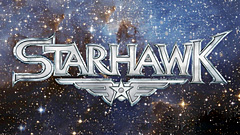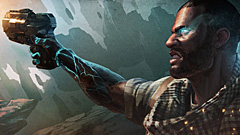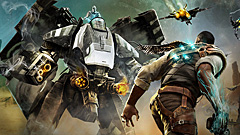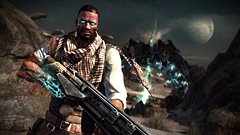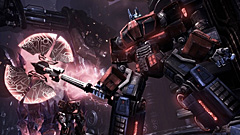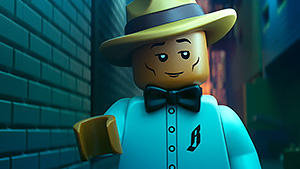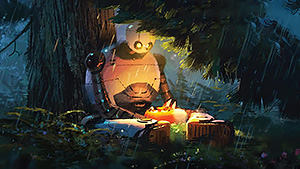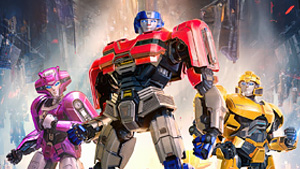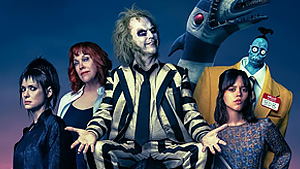May 15, 2012 by Paul Curtin


Despite starting out as a singleplayer-only title over fifteen years ago developed by SingleTrac for the original PlayStation, the Warhawk (now Starhawk) franchise has still yet to become a household name. After skipping the second generation of the PlayStation, Incognito Entertainment (made up of SingleTrac staff) ended up dropping the series’ singleplayer component in 2007 and releasing Warhawk as a multiplayer-only PlayStation 3 game that offered a similar experience as a third person Halo but with the gimmick of using the PS3’s six-axis motion controls to fly vehicles. While nether the motion controls or Warhawk became huge hits like Halo, the game received positive reviews and developed a large following of die-hard fans, so much so that it warranted another sequel.
Once again reforming and re-branding under the name Lightbox Interactive, some of the original developers have come back to release their best game yet. Starhawk is visually a huge upgrade over Warhawk and is packed with far more content than the previous two games combined by offering both multiplayer and singleplayer — the latter of which might have been better off scrapped like the six-axis controls and the previous game’s singleplayer in order to solely focus on mutliplayer.
Taking place in a distant future, Starhawk’s story focuses on humans colonizing planets and mining an energy source known as “Rift Energy.” As a result, a new gold rush begins, and it’s the job of space cowboy Emmett Graves to protect the human miners from Outcasts who have been mutated by the Rift Energy and now defend it. The story has an interesting family feud dynamic with Emmett being part Outcast after a mining accident that also caused his brother to become fully consumed by the Rift Energy and go over into the dark side, but due to the way the story is presented, it never really takes off.

Unlike StarCraft and most other games, Starhawk’s narrative cutscenes are actually done with worse graphics than the gameplay. The actual gameplay’s visuals aren’t stunning but still a massive upgrade from Warhawk; however, the use of unique hand-drawn animations ultimately hurts the story by distancing itself too much from the gameplay. Characters are underdeveloped and although each level is interesting, like the characters, none of the various space landscapes get enough time to let a player build any attachment to them. Clocking in at around only six hours, the story is more of a glorified tutorial that helps players learn how to play before (literally) dropping them into multiplayer, where the game shines brightest.
If you’ve never played Warhawk on the PS3, Starhawk can best be described as Halo but with a greater emphasis on big team battles (16 vs. 16) and dog fights in the air. Starhawk offers a wide range of customization and unlockable talents via a great leveling system and an clever use of local split screen that makes playing with a friend enjoyable by keeping a widescreen ratio similar to when playing alone and adding a larger minimap to the side of each player’s screen to fill in the gaps. But what takes the series and all of multiplayer gaming to the next level is the new “Build n’ Battle” system that wasn’t in Warhawk and allows any player, at any time, to build structures such as vehicle-producing factories, walls, and turrets like you would find in an RTS (real-time strategy) game like StarCraft.
Build n’ Battle is pure genius, and despite being somewhat complex with how many different structures you can build, it ends up working perfectly and is even surprisingly easy to do using a PS3 controller. Players just have to rack up points by collecting Rift Energy orbs after completing objectives and killing other players, which allows them to hit one button to bring up a building wheel and select various structures to airdrop, like tank- and Hawk-producing factories. The way buildings look when falling from the sky or how players drop in when respawning is crazy in itself (think the live-action Halo 3: ODST ads), but the ability to essentially weaponize yourself or buildings by aiming and trying to drop them on top of unsuspecting suckers (instantly killing them, of course) makes you think… Why hasn’t anyone ever done this before?

There are certain limitations as to where you can build, but for the most part the system works flawlessly with the exception of being stuck on a team that doesn’t work together. Fans of multiplayer games will love the huge role that teamwork plays. A team’s success lies solely on the players themselves as a team can simply leave their flag wide open for the enemy to snatch up or work together to build a massive fortress with multiple levels of walls and turrets that requires an all out assault to breach. When two teams are going at it back and forth in a game of Capture The Flag or Zones and actually working together and giving each other a challenge, the gameplay can be insanely intense and better than anything else offered in a multiplayer game.
The maps are all designed perfectly for big team battles and by allowing players to build massive structures anytime, anywhere, on the map, there’s never any shortage of vehicles. Other massive battlefield type games usually only give teams a handful of vehicles, which results in players arguing and sometimes even killing one another over so that they’re not left in the dust and out of the action taking place miles away. In Starhawk, even if somebody steals your vehicle, you can usually just drop a brand new vehicle manufacturing plant out of the sky and instantly chase after your enemy or towards the objective with little down time between the action as the game’s epic music picks back up to get you in the mood for making your own blockbuster chase sequence.
Like the original, Starhawk also has jets called “Hawks” that players can build on the fly, but the Hawks have received an amazing upgrade that allows them to instantly be transformed back and forth between the Hawk jet mode and a walking ground mech. The Hawks combined with other vehicles like tanks and trucks with mounted turrets make multiplayer matches pretty astonishing with basically two battles going on at once, one on the ground and one in the air. A lot of the time both battles will come together for pure craziness wherever the objectives are, all while massive factories and soldiers are falling from the skies and crashing into the ground (or players).

There aren’t many multiplayer games out there with vehicles that allow for multiple people to use at once effectively, like Halo and Battlefield do so well. But the vehicles work even better than both Halo and Battlefield and are key to capturing enemy flags on larger maps. Vehicles are also greatly balanced and easy for players on foot to go head-to-head with, so don’t worry about somebody getting into a jet and flying around in god mode as everyone else runs to hide. Whether controlling a soldier on the ground, in a tank, or in a hawk, the transition is always smooth and never disrupts the flow of the action. My only complaint would be that I wish the aiming controls while shooting on the ground were a little more precise. It can sometimes be a little frustrating when chasing an enemy amongst all the chaos and missing half your shots when they’re only twenty feet away because they’re frantically bunny-hopping and you haven’t yet mastered the aiming.
The Verdict
With all new multiplayer innovations, mixed with spectacular team gameplay and good graphics that rarely lag with more onscreen chaos than anything we’ve ever seen, Starhawk’s gameplay is unlike anything before it – which is rare in today’s era of milking franchises and releasing sequels annually. It’s refreshing to see a developer take their time and release a true sequel that introduces new features that many other games will copy in the future. If anything, Lightbox should have maybe scrapped the singleplayer again in order to focus more on multiplayer and add a couple other objective-based modes, but with free DLC maps already announced instead of the current trend of Day 1 paid DLC, it’s hard to find fault in anything Lightbox has done or has planned for Starhawk‘s evolutionary multiplayer shooter-RTS hybrid experience. Starhawk gets a 4.5 out of 5 (Amazing).
The Pros
- Gameplay perfectly combines shooter and RTS elements
- Crazy multiplayer experience unlike anything else
- Multiplayer has a strong emphasis on teamwork
- Tons of customization and unlockables to keep players interested
- All future DLC map packs will be free
- Brilliant use of local two player split screen
The Cons
- Weak and short singleplayer campaign
- Only four main multiplayer modes
- Aiming controls could be a little more precise



